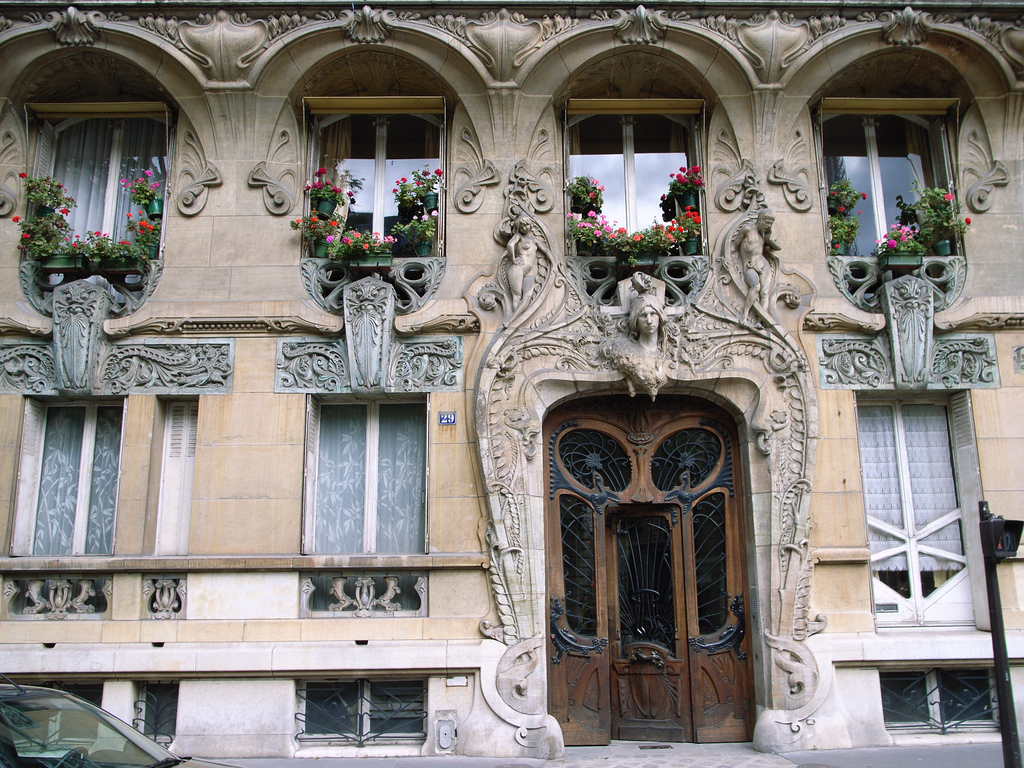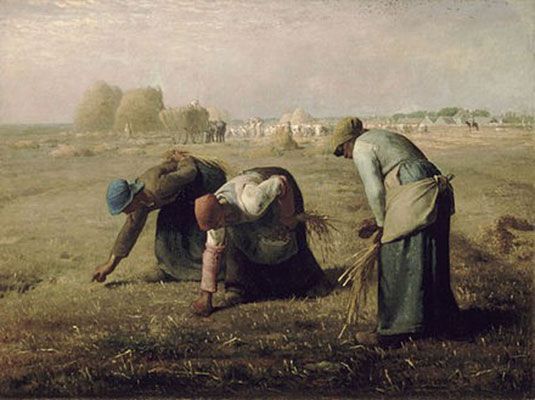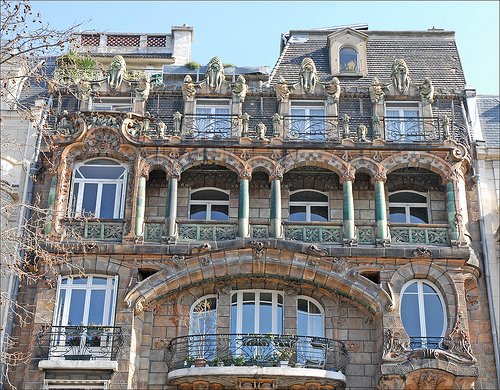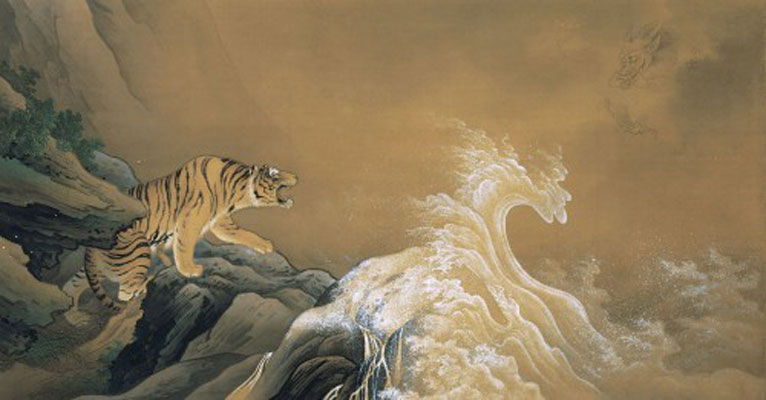The Era
The Romantic Era took place during the 1800's, the predominant art styles of this period included the romantic, realist, impressionism and post-impressionism, and art nouveau styles. There were many new styles of art as exploration and shifts in society continued to expand, as well as some styles being created in direct opposition of another art style. As the world continued to evolve, as did the art world.
I am choosing to focus on art nouveau and the realist movements, but I cannot truly saw I choose one style over another. These two styles are drastically different from each other visually, both groups made stances for their own beliefs. The realists were anti-institutional and sought to take a moral stance against the bourgeois, and the art nouveau sought to bring back quality craftsmanship and step away from historical styles of the past and rebel against academic art.
Alphonse Mucha - Art Nouveau
.jpg)
This art nouveau ballet poster is by Alphonse Mucha, who was a prominent figure of this movement. This poster exemplifies the art elements that make art nouveau; muted colors, flowy and organic ornamentations, and taking inspiration from nature. The muted color palette is throughout the poster and the natural elements is seen with the floral decorations on Princess Hyacinth. The iconic art nouveau ornamentations is seen within the circle that goes around Princess Hyacinth; if you look closely at it you can see motifs that relate to the story of the ballet such as blacksmith tools, a crown, and sorcery instruments.
I highly recommend browsing other works by Mucha, I enjoy a lot of his posters and designs. The only criticism I have is that a lot of his female characters look very similar to one another, but he did do a lot of series of paintings, such as a series titled The Moon and Stars, so that may be why.
Jules Lavirotte - Art Nouveau

Lavirotte building(1899-1901) by Jules Lavirotte, Paris, France. Courtesy of Un Jour de Plus a Paris
This apartment building in Paris, France was designed by Jules Lavirotte and had won a facade competition in 1901. Looking at the decorations around the doors, windows, and balconies you can see how many curved and organic lines that make up the design. Above the entrance you see a woman, it is not clear who the inspiration for her is but some say it was based on Lavirotte's wife, and to the sides of her are Adam and Eve. What many art nouveau artists strived for was to bring back craftsmanship and break away from traditional designs, which is what he accomplished. The outside has glazed ceramic tiles which was new at the time, and the sculptures and ironwork were designed by Lavirotte, but made by local craftsmen. Inside the structure he used an early form of reinforced concrete and built the walls to have a layer of air in them to provide better soundproofing.
While I may not build an apartment like this, at the time it was innovative and new techniques were used during the construction.
I like art nouveau art and furniture design, but for me the architecture falls a little flat compared to other styles. I do like all the curves in the design of the building and how the decorations are nature inspired such as the iron lizards that decorate the door (a little hard to see in the photo above). The one criticism I would have is the supposed erotic elements of the building, while I am not sure it is intentional it is how some interpret some of the elements. Some of these elements include the phallic looking door, the iron lizards I liked so much are supposedly in reference to a French term for genitals, and some people say they see other erotic imagery within the decorations. I'm not sure how common it was for buildings to have such elements, to me it seems out of place in a building you would live in.
Top portion of the Lavirotte building
Jean-François Millet - Realism
The Gleaners (1857) by Jean-François Millet, France. Courtesy of The Art Story
Millet, like many realist painters, depicts non-idealized events of the working class. Gleaners were workers who came after harvesters to pick up anything that was left behind. It is said that Millet chose to paint three women to represent the three movements gleamers did; bend, pick, and stand back up. What I really like about the realist movement is the artists stance to show everyday life, even if people thought it was ugly and not catering to the tastes of the wealthy. When Millet had this painting on display in France, there were many reviews that called it ugly and the women homely.
The elements of art that I like about the painting are the color palette, form, and texture. The muted colors adds to the sense of everyday and that these are workers going about their day, nothing glamorous. The form of the women gives a sense of them being three dimensional in this space, you can see their shadows and depth in the painting. There isn't a lot of texture, it mainly is within their clothing and the grass from the field.
Gustave Courbet - Realism
Young Ladies of the Village(1851-1852) by Gustave Courbet, France. Courtesy of The Met
Courbet is another French realist who was criticized for making the figures "ugly". Which I don't agree with, they look fine to me, and he had based the women on his sisters so I doubt he thought they were ugly. He was also criticized for the size of the cows, which I can agree with, they look too big to be part of the background and too small to be part of the foreground compared to the size of the dog.
Courbet did paintings to showcase his hometown of Ornans and those who live there, he also wanted to capture everyday life even if it seemed flawed or what wasn't considered beautiful. I love the texture on the dog, you can see how fluffy he is and there are patched of dirt and rock that you can just picture how they feel. The perspective is off, the cows are definitely the wrong size, but I don't think it throws off the whole painting as the focus is on the figures. I like that it shows real people going about their day, something I think is important that helps us today get a sense of what life was like during this period
Final Thoughts
I couldn't find a movement of art that I truly didn't like, I feel there will always be pieces in each movement that you like or dislike. It is interesting that many of these styles were happening at the same time or just right after the other one went out of style. Personally, the flair of art nouveau is more visually interesting, but I do like the everyday aspect of many of the realist paintings.
Sources
“Art Nouveau Architecture in Paris' 7th Arrondissement.” Paris Perfect, 28 Sept. 2020, www.parisperfect.com/blog/2011/03/art-nouveau-7th-arrondissement/.
“Art Nouveau Movement Overview.” The Art Story, 21 Jan. 2012, www.theartstory.org/movement/art-nouveau/.
Foundation, Mucha. “Princess Hyacinth.” Mucha Foundation, www.muchafoundation.org/en/gallery/browse-works/object/246.
“Gustave Courbet Paintings, Bio, Ideas.” The Art Story, 21 Feb. 2010, www.theartstory.org/artist/courbet-gustave/.
Ibrahim, About Afzal. “The Gleaners.” Artist PopLab, 27 Apr. 2020, www.theartist.me/artwork/the-gleaners/.
“Realism Movement Overview.” The Art Story, 21 Mar. 2015, www.theartstory.org/movement/realism/.
“Young Ladies of the Village.” Metmuseum.org, www.metmuseum.org/art/collection/search/438820.


Hi Jada! I totally understand your conflict in choosing a favorite style.
ReplyDeleteI respect the moral values of the Realists so much, and the style is not only breathtaking but reverent of ordinary life and people.
On the other hand, I just want to lose myself in the whimsical intricacies of Art Nouveau. The way the flowing lines and rich patterns and subdued colors combine transports me to another world. Why shouldn't art portray and make us feel such things?
Today I'm feeling like an amoral fantasist who just wants pleasant dreams so I'm going with Art Nouveau.
At your suggestion I looked into more of Alphonse Mucha's work and I wasn't disappointed. He worked in such a wide variety of mediums! I was interested to learn that he designed all kinds of intricate jewelry. His Slav Epic series of paintings is unlike anything I've ever seen and I'm so glad I discovered it.
You did an amazing job posting your blog. At first, I did not realize the buildings were in the Romantic Era as well. They are quite different from the other paintings, but they have their own uniqueness. They are incredibly detailed. Thank you for sharing. I also agree with you. I did not find many artworks that I particularly enjoyed. This is not one of my favorite eras.
ReplyDeleteHello,
ReplyDeleteI also liked the art nuoveau style. I think its cool how entertainment posters were created using this type of art in the Romantic era. In the poster that you posted called Princess Hyacinth, I love the use of geometric lines and patterns used. I also like the colors used which I think gives it a natural earth feeling. Even though this style of art was created in the 1800's you can see this type of art in modern day rock and roll entertainment posters. Which is where I first noticed the ornamental style of art using long curved sensuous feminine lines, patterns and lines without sharp angels and the use of muted colors. You can see rock bands such as Guns and Roses, Grateful Dead and Widespread Panic using this style on their record covers and concert posters. Am I showing my age? lol! Thank you for your blog this week - Good Job!
Hi Jada! Thank you for sharing your point of view on this weeks theme! I really love the pieces you decided to choose. The Alphonse Mucha painting really caught my eye. In a way it kind of looked modern through her pose and facial expressions. On the other hand, between the two styles you have chosen, I think I prefer the realism pieces. I like the element of movement that is used and the audience is allowed to use their imaginations. It makes me feel like I get to be set in a real scene and moment in time.
ReplyDeleteI also had a hard time choosing between each one because each had their merit and demonstrates boldness to do something novel or contrarian. The Courbet painting's background is interesting, and so are the subjects. The center cow looks almost as if it was added late, or hastily, or it might be intentional. I like the effect of putting the women in focus against a passing or active background. Overall i think its an unusual and nice painting.
ReplyDelete